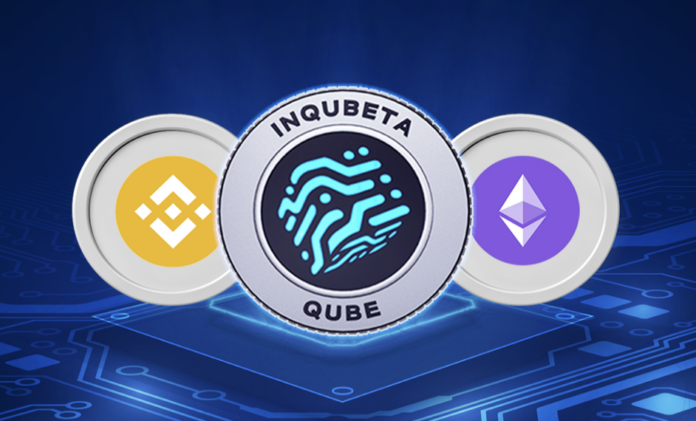In this article, we’ll be highlighting three remarkable crypto projects that are expected to make waves in the upcoming bull run – according to crypto analysts. Delve into the world of futuristic investments with InQubeta, the crypto crowdfunding platform transforming AI startup investments.
Additionally, explore the dynamic potential of Ethereum, the pioneering smart contract platform, and Polkadot, the creative multi-chain ecosystem, as they emerge as the top contenders in the competitive realm of blockchain technology.
InQubeta: Taking AI Startup Investment To The Next Level
A lot of investors are tired of the same opportunities and want to add some excitement to their portfolio, now, they need to look no further than InQubeta. InQubeta is not an average crypto crowdfunding platform – it’s here to shake the space up. This project proves that traditional investment methods can be a thing of the past, as the world’s first crypto crowdfunding platform that enables fractional investment in AI startups using $QUBE tokens is introduced.
With InQubeta, individuals can dive into the world of AI startups and invest in a manner that suits their budget. The NFT marketplace of InQubeta is buzzing with opportunities where AI startups raise funds and offer reward and equity-based NFTs. The intriguing aspect is that each investment opportunity is minted into an NFT and fractionalized, allowing individuals to participate without incurring significant costs.
InQubeta has even taken things a step further with their deflationary ERC20 token, $QUBE. This is not just an ordinary token; it is a deflationary currency that becomes even more valuable over time. A 2% tax on all buy and sell transactions is directed to a burn wallet, resulting in the token becoming scarcer. Additionally, a 5% sell tax is allocated to a dedicated reward pool, providing an opportunity for individuals to earn rewards by staking their tokens. InQubeta offers a project that holds great potential, and AI fans should definitely take note.
Ethereum: Unleashing the Power of Smart Contracts and Decentralized Applications
When it comes to blockchain platforms, Ethereum stands tall as the original pioneer and a force to be reckoned with. Born in 2015, Ethereum introduced the concept of smart contracts, which transformed the way transactions are executed on the blockchain. This decentralized platform allows developers to build and deploy their own applications without relying on intermediaries, offering a level of transparency and security that traditional systems can only dream of.
One of Ethereum’s major strengths lies in its vast network and active community. Developers from all corners of the world have flocked to Ethereum, creating a vibrant ecosystem of decentralized finance (DeFi) projects, non-fungible tokens (NFTs), and inventive dApps that cover a wide range of industries. This rich ecosystem has solidified Ethereum’s position as the go-to platform for creating and launching new tokens, conducting initial coin offerings (ICOs), and experimenting with novel financial instruments.
Scalability has been a challenge for Ethereum, as increased usage has resulted in network congestion and high fees. However, Ethereum is addressing these issues through the implementation of Ethereum 2.0, a major upgrade that introduces a new consensus mechanism called Proof of Stake (PoS) and shard chains. This upgrade aims to significantly enhance scalability, security, and energy efficiency, making Ethereum even more robust and attractive to developers and users alike.
Polkadot: Unlocking a New Era of Blockchain Interoperability and Scalability
Polkadot emerges as a remarkable project that seeks to bridge the gap between different blockchains. Founded by one of Ethereum’s co-founders, Polkadot introduces a multi-chain framework that enables interoperability, allowing various blockchains to perfectly communicate and share information with each other.
Polkadot’s architecture revolves around a relay chain that serves as the heart of the network, coordinating communication and consensus between connected blockchains, known as parachains. These parachains operate independently, each with its own unique features, governance models, and specialized functionalities. This modular approach provides flexibility and scalability, as new parachains can be added without disrupting the entire network.
By facilitating interoperability, Polkadot opens up a world of possibilities for cross-chain applications and collaborations. Developers can create decentralized applications that can interact with multiple blockchains, harnessing the strengths and features of each chain to enhance functionality and efficiency. This interoperability also paves the way for secure asset transfer between different chains, enabling new use cases and driving invention in areas such as decentralized finance, supply chain management, and gaming.
Polkadot’s governance model, based on on-chain voting and a nominated proof-of-stake consensus mechanism, ensures that decisions regarding network upgrades and the addition of new parachains are made in a transparent and decentralized manner. This community-driven approach fosters inclusivity and empowers stakeholders to actively participate in shaping the future of the Polkadot ecosystem.
Conclusion
Respected crypto analysts recognize the immense potential of these projects and believe they are well-positioned to thrive in the evolving crypto landscape. As the market gears up for the next bull run, investors should pay close attention to InQubeta, Ethereum, and Polkadot, as they represent exciting opportunities for growth and creativity in the crypto space.
Visit InQubeta Presale
Disclaimer: This is a sponsored press release and is for informational purposes only. It does not reflect the views of Crypto Daily, nor is it intended to be used as legal, tax, investment, or financial advice.
Credit: Source link






















 Bitcoin
Bitcoin  Ethereum
Ethereum  Tether
Tether  Solana
Solana  USDC
USDC  XRP
XRP  Lido Staked Ether
Lido Staked Ether  Dogecoin
Dogecoin  Toncoin
Toncoin  Cardano
Cardano  Shiba Inu
Shiba Inu  Avalanche
Avalanche  TRON
TRON  Polkadot
Polkadot  Wrapped Bitcoin
Wrapped Bitcoin  Bitcoin Cash
Bitcoin Cash  Chainlink
Chainlink  NEAR Protocol
NEAR Protocol  Polygon
Polygon  Internet Computer
Internet Computer  Litecoin
Litecoin  Uniswap
Uniswap  Fetch.ai
Fetch.ai  LEO Token
LEO Token  Dai
Dai  Ethereum Classic
Ethereum Classic  Hedera
Hedera  Aptos
Aptos  First Digital USD
First Digital USD  Cronos
Cronos  Stacks
Stacks  Cosmos Hub
Cosmos Hub  Mantle
Mantle  Pepe
Pepe  Filecoin
Filecoin  Immutable
Immutable  Render
Render  Stellar
Stellar  dogwifhat
dogwifhat  XT.com
XT.com  OKB
OKB  Renzo Restaked ETH
Renzo Restaked ETH  Optimism
Optimism  Bittensor
Bittensor  Arbitrum
Arbitrum  Maker
Maker  Wrapped eETH
Wrapped eETH  The Graph
The Graph 
